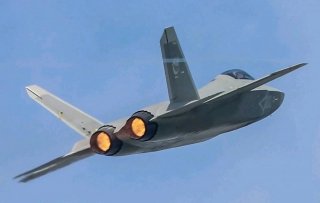China's J-31 (or FC-31) Stealth Fighter Is No F-35
Beijing most likely stole a lot of the data to make the J-31 from the U.S., however, this plane can't compete with the F-35. Here's why.
A new, yet unverified social-media picture of China’s J-31 5th-Gen stealth fighter, sometimes referred to as the FC-31, may indicate that the airplane has been upgraded with new avionics, according to a report published in the South China Morning Post, cited by Newsweek.
The photo, see above, reportedly appearing on a Chinese social media site called Weibo, may show a recent test flight of the FC-31 Gyrfalcon fighter. The Newsweek report includes some observations of the aircraft which could indicate that the Chinese have made some technical adjustments.
“Earlier prototypes showed an airspeed measurement device on the nose of the stealth fighter, but this appears to be missing from the latest version. This might indicate the jet now has fitted avionics, the Post noted. The newspaper also said the canopy over the FC-31's cockpit now appears more similar to the J-20, plus changes to improve the jet's wind resistance,” the Newsweek report states.
This observation raises several interesting questions about the emerging Chinese fighter, a maritime variant of which is believed to be intended to fly from carriers. It is well known that the J-31 is without question intended to function as a counterbalance or rival to the F-35. Its exterior appears to be a transparent F-35 “rip-off” in terms of its stealth configuration, yet a full margin of comparison, it would seem, hinges more fully on avionics, sensors, weapons, engine propulsion and maneuverability, all things less detectable to an observer’s eye.
Interestingly, its visible similarity to the F-35 does not, by many estimations, appear to be accidental. A Congressional report from many years ago, the 2014 U.S.-China Economic and Security Review, specifically cites a 2010 Defense Science Board report finding which stated that Chinese cyber espionage led to the theft of numerous U.S. weapons specs, to include the F-35.
As recently as last year, a Global Times report said the J-31 showed design improvements at the 2019 Paris Air Show. Photos from the story reveal profound visual similarities between the F-35 and J-31.
This is not without precedent, as the Chinese media itself has noted similarities between the two aircraft. Portions of a story from the Chinese government’s “People’s Daily Online” as far back as 2013 specifically cites design similarity between the emerging Chinese J-31 and the F-35, writing that the “J-31 and F-35 use the same DSI inlet (non-boundary layer-separated lane supersonic inlet).” The only major difference, the paper notes, is that the U.S. has an F-35B Short Take-Off and Landing variant and that the J-31 uses two engines compared to the F-35’s single-engine propulsion configuration.
Therefore, despite its apparent external similarity, there does not appear to be any kind of decisive indication or evidence that the aircraft does truly rival the F-35 in any measurable way.
Upgrades Coming?
However, should there be a sensor upgrade of some kind, or improvements to the J-31s avionics as suggested in the story, that could be considered substantial. The advantages of the F-35, many maintain, reside in its description as a “flying computer” engineered with advanced, high-resolution, long-range sensors able to detect and target enemy targets before the aircraft itself is seen.
The Chinese are known to be quite advanced in the area of AI, yet that might not mean that the J-31 is comparable in terms of the “sensor fusion,” weapons range or even maneuverability of the F-35. Nonetheless, the aircraft is expected to bring new threats to the equation, particularly when it comes to maritime attack. Should the J-31’s functional capability, weapons, speed and attack envelope mirror the F-35, the new Chinese aircraft might erode the clear Naval airpower advantage provided by the U.S. F-35B and carrier-launched F-35C.
Kris Osborn is the new Defense Editor for the National Interest. Osborn previously served at the Pentagon as a Highly Qualified Expert with the Office of the Assistant Secretary of the Army—Acquisition, Logistics & Technology. Osborn has also worked as an anchor and on-air military specialist at national TV networks. He has appeared as a guest military expert on Fox News, MSNBC, The Military Channel, and The History Channel. He also has a Masters Degree in Comparative Literature from Columbia University.
Image: Weibo.

